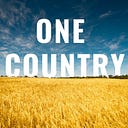Beyond the Beltway Media Bubble
The rise of digital media has created a negative feedback loop between publishers and rural communities, which in turn drastically affects the social fabric of the United States. As traditional media publications have shuttered and employment numbers plummeted, an increasing number of communities have become “news deserts” — communities that have no news outlet that serves them. As rural voices are lost and reporting is increasingly centralized in urban centers, the gap between America’s heartland and the Beltway increases.
There is nothing inherently wrong with digital publishers or broadcasters, however these industries are clustered in large urban markets like New York City and Washington, D.C., unlike their traditional media counterparts. With physical concentration comes the gradual abandonment of large swaths of the country, and these trends hit rural areas hardest.
We’ve seen this before: rural voters feel ignored, the coastal elites write their stories from afar — perhaps after visiting for just a few hours — and resentment builds. A 2018 analysis of rural news coverage revealed 60 percent of rural Americans believe the media respects them “not at all” or “only a little.”
A snapshot of last month’s headlines illustrates this point clearly. From April 1–5, the Des Moines Register ran seven stories on the Midwest flooding. The New York Times, by contrast, ran one major story on the floods. For comparison, the Times printed three major stories on the mayoral race in Chicago which, though historic in its own right, unarguably carries less national significance than floods that caused billions in damage, affected millions of lives, and will take years to recover from.
You may think, “Wait a minute! The flooding was at its worst in mid-March, not early April.” You’d be correct, and therein lies the rub: while rural communities live in one reality — where flooding concerns are sustained and the fallout long-felt — national papers cast a cursory glance when it is most sensational, and then abandon the story for the next flavor of the week.
As with media coverage, the political attention of Washington’s current leadership has waxed and waned when convenient. During campaign season, Trump was quick to embrace rural America and make grand promises — but in the off season he ignored their plight and focused on damaging trade wars and budget cuts instead.
There are many factors at play here: from shifts in publishing, to the devastation of local papers, to the discrepancies in duration and focus of coverage — but they all lead to the same place — rural Americans being left behind and their stories going unheard. This is not an assault on journalists, who have themselves been pummeled by the dramatic changes in the news industry and who have seen record layoffs and a demand to do more and more with less and less. However, something must change. The free press has a responsibility not to abandon the American Heartland for convenience’s sake.
This report is the first in a series of One Country Project rural press analysis — stay tuned for more insights on the coverage gap.
The One Country Project, led by former Senators Heidi Heitkamp and Joe Donnelly, is working to reverse the erosion of rural support for Democratic leadership. One Country is reengaging with the American Heartland, serving as a clearing house of research and information for rural Americans and Democrats working to serve these communities.
